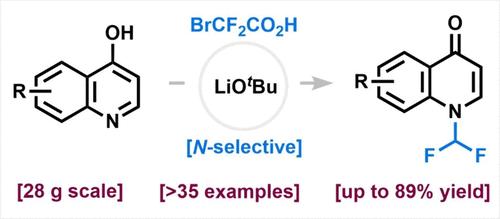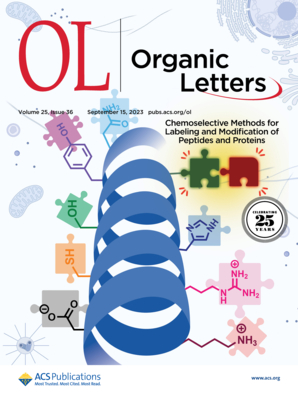4-羟基喹啉的n选择性二氟甲基化
IF 5
1区 化学
Q1 CHEMISTRY, ORGANIC
引用次数: 0
摘要
4-羟基喹啉的N-选择性二氟甲基化是一个艰巨的挑战,由于竞争的N-和o -二氟甲基化途径。在此,我们提出了一种温和、高效、可扩展的方案,使用BrCF2CO2H和LiOtBu选择性地对4-羟基喹啉进行n -二氟甲基化。该方法可耐受反应性官能团,如羧酸、酯和酰胺。还合成了一系列n -氘二氟甲基类似物(−CF2D)。本文章由计算机程序翻译,如有差异,请以英文原文为准。


N-Selective Difluoromethylation of 4-Hydroxyquinolines
N-selective difluoromethylation of 4-hydroxyquinolines is a formidable challenge due to competing N- and O-difluoromethylation pathways. Herein, we present a mild, efficient, and scalable protocol using BrCF2CO2H and LiOtBu for the selective N-difluoromethylation of 4-hydroxyquinolines. This method tolerates reactive functional groups such as carboxylic acid, ester, and amide. A series of N-deuterodifluoromethyl analogues (−CF2D) is also synthesized.
求助全文
通过发布文献求助,成功后即可免费获取论文全文。
去求助
来源期刊

Organic Letters
化学-有机化学
CiteScore
9.30
自引率
11.50%
发文量
1607
审稿时长
1.5 months
期刊介绍:
Organic Letters invites original reports of fundamental research in all branches of the theory and practice of organic, physical organic, organometallic,medicinal, and bioorganic chemistry. Organic Letters provides rapid disclosure of the key elements of significant studies that are of interest to a large portion of the organic community. In selecting manuscripts for publication, the Editors place emphasis on the originality, quality and wide interest of the work. Authors should provide enough background information to place the new disclosure in context and to justify the rapid publication format. Back-to-back Letters will be considered. Full details should be reserved for an Article, which should appear in due course.
 求助内容:
求助内容: 应助结果提醒方式:
应助结果提醒方式:


